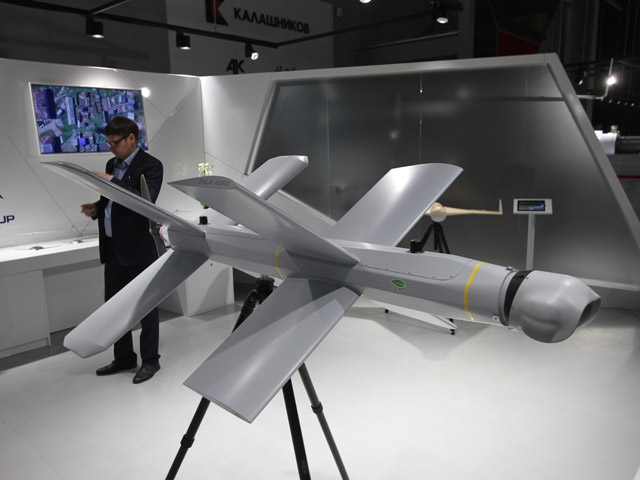On Friday, February 18, the Russian state agency RIA Novosti, citing a military-diplomatic source, reported that the Russian military used the upgraded Lancet-3 barrage ammunition in Syria for the first time as part of tests. Judging by the statement of this source, the ammunition was used to strike terrorist positions.
According to the source, a deeply modernized version of the Russian kamikaze drone “has received updated aerodynamics – now it has one large X-shaped wing and X-shaped plumage in the tail, and not two symmetrical X-shaped wings, as before.”
Earlier, footage was shown of the use in Syria of the basic version of the Lancet-3 drone developed by Zala-Aero (part of Kalashnikov). That version has two X-shaped wings and is capable of carrying a warhead weighing three kilograms. The upgraded version of the Lancet-3, judging by the RIA Novosti report, can carry a larger warhead. The flight time of this version of the kamikaze drone is 40 minutes, the maximum speed is 110 kilometers per hour.
Recall that on April 16, 2021, the Russian website Vesti.ru published an article titled “As simple as AK-74: Izhevsk presented the Lancet-kamikaze for special forces”, dedicated to the combat use of the ZALA Lancet loitering ammunition in Syria. The author of the publication, Alexander Rogatkin, highly appreciated this munition, noting: “The Lancet drone is also called the flying Kalashnikov for its simplicity, reliability and efficiency.” This article cited a comment by the chief designer of ZALA Aero Group (part of the Kalashnikov group of companies) Alexander Zakharov, who, answering the question “How far are we behind in these technologies?”, Said: “No, no, no! This is generally the wrong question I will tell you more: today, I believe that not only we are not lagging behind, but there are already tendencies that the same Israel is copying some things from us.
On April 18, 2021, Rogatkin’s report was shown by the Russian state television channel Vesti. After that, the Russian state agency RIA Novosti published an article under the heading “Israel copies the technology of Russian drones, the designer said.” It was no longer about “some things”, in the publication, with reference to Zakharov, it was said about copying technologies.
Citing its own source in the military-industrial complex, the RIA Novosti agency wrote last year that Russian special forces have used several dozen Lancet-3 drones since 2020 to strike at international terrorists in Syria. According to this source, for testing in combat conditions, an experimental batch of Lancet loitering ammunition developed by Kalashnikov was delivered to the Russian group of troops in Syria. Other Kub kamikaze drones, also manufactured by ZALA Aero, have been in use in Syria since 2019, the Russian agency wrote.
Back in the summer of 2019, a military observer for the Israeli Keshet TV channel, Nir Dvori published on his Twitter page a photo of a “new development” of the Russian concern “Kalashnikov”. According to the journalist, the presented loitering ammunition ZALA Lancet-3 is very similar to some kind of Israeli secret development. The administrator of the army.fresh.co.il military forum, Yosifun Kaufman, for comparison, cited a photo of the Hero 400EC loitering ammunition, created by the Israeli company UVision, for comparison. There is an obvious similarity in appearance and technical characteristics, although there are certain differences.
Denis Fedutinov, one of the leading Russian experts in the field of unmanned aerial vehicles, agreed with the opinion of Israeli experts. At the request of the NEWSru.co.il editors, he commented on the new statement of the chief designer of Zala A. Zakharov. “Developers of aviation technology, including such a dynamically developing part of it as unmanned technology, are always watching competitors from other companies and often use some other people’s technical ideas. As a rule, these are external borrowings simply because the internal structure is rarely disclosed in detail. As a result, when observing products offered by companies from different countries, sometimes there is a feeling of something previously seen that goes beyond the thesis that “all aircraft are the same.” For example, such a feeling of some commonality arises when looking at the loitering ammunition of the Lancet family of the Russian company ZALA Aero and loitering ammunition of the HERO family of the Israeli company UVision. In such cases, in order to understand who is the “donor” and who is the “recipient”, as a rule, it is enough to refer to the timing of the appearance of certain systems, “says Fedutinov.
Loitering ammunition Hero 400EC (advanced version of Hero-120) of the Israeli company UVision was presented at the air show in Paris in June 2019. For the first time, an Israeli “kamikaze drone” of the Hero class was presented to the general public at the Paris Air Show in Le Bourget in 2015 (in the same year, ZALA became part of the Kalashnikov group of companies, having not introduced a single drone of this class to the market at that time) . Back in 2011, at the Paris Air Show in Le Bourget, one of the early versions of Hero (UVision) loitering ammunition could be seen.
It should be noted that the KYB (“Cube”) unmanned aerial vehicle, which self-explodes when approaching the target, has an outward resemblance to the Orbiter 1K loitering kamikaze UAV, created by the Israeli company Aeronautics Defense Systems. However, according to D. Fedutinov, KYB was closer to the Warmate system of the Polish company WB Electronics.
Presentation video ZALA Lancet (“Kalashnikov”, Russia)
https://www.youtube.com/watch?v=afXRx53bopo
Presentation video Hero 400EC (UVision, Israel)
